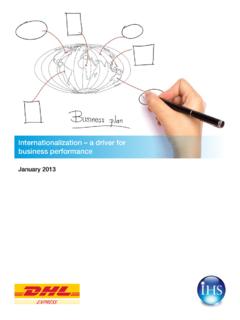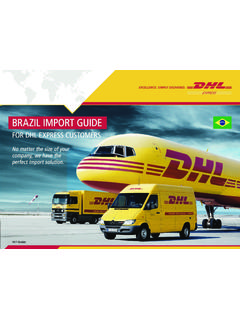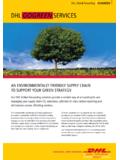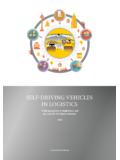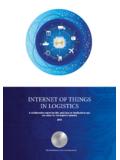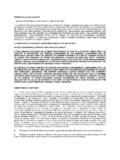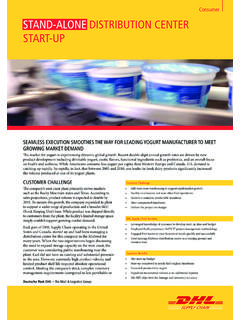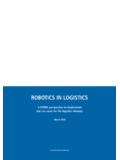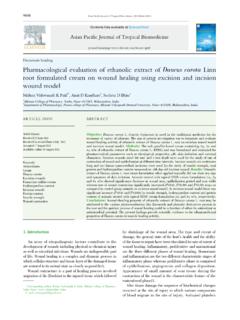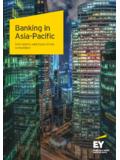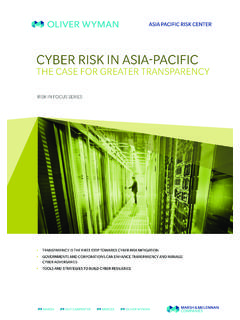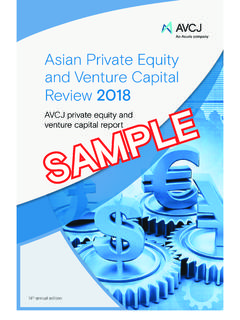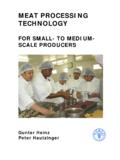Transcription of DEMYSTIFYING ASIA PACIFIC TRADE TRENDS - …
1 DEMYSTIFYING asia PACIFIC . TRADE TRENDS . A DHL Perspective on Implications for Supply Chains May 2016. asia PACIFIC Insights Powered by DHL Trend Research ABOUT THE PAPER PROJECT MANAGEMENT AND EDITORIAL OFFICE. In the current fragile global macroeconomic environment, Tamanna Dahiya, DHL asia PACIFIC Innovation Center the asia PACIFIC region, hereafter APAC, remains a region of Keya Chaturvedi, DHL asia PACIFIC Innovation Center optimism. It is positioned to be the world's fastest growing region, with GDP growth in 2017 estimated at 6% compared to in the EU and in Latin How could ACKNOWLEDGEMENTS. the relative importance of this region change and what are Professor Deborah Elms the key TRENDS and challenges in APAC markets? What can Executive Director, Asian TRADE Centre businesses expect to see in a few years and how may this impact supply chains in the region?
2 R Alfred Goh M. Senior Vice President, Global Head, This paper seeks to demystify the TRADE TRENDS and implications Fast Growing Enterprises (FGE), DHL. in a complex economic region that, until now, has seemed inconsistent and changeable. It provides a succinct summary Mr Lee Eng Keat of the TRENDS and challenges in APAC markets and their Director, Natural Resources & Logistics, implications for the supply chain. Findings are based on a Singapore Economic Development Board synthesis of desk research, in-depth interviews, and a research survey of 56 companies in the region, conducted jointly by Mr Malcolm Monteiro DHL and IDC. CEO asia PACIFIC , DHL eCommerce DHL Public Policy and Business Experts PUBLISHER. DHL Customer Solutions & Innovation DHL-IDC Manufacturing Insights Survey Participants Represented by Matthias Heutger Senior Vice President DHL Fast Growing Enterprises Shanghai Business Strategy, Marketing & Innovation Forum Participants DHL asia PACIFIC Innovation Center (APIC) Visitors PROJECT DIRECTOR from Businesses & Government Agencies Pang Mei Yee Vice President, Innovation, Solution Delivery &.
3 Service Management, asia PACIFIC IN COOPERATION WITH: World Economic Outlook, IMF, 2016. 1. DEMYSTIFYING asia PACIFIC . TRADE TRENDS . A DHL Perspective on Implications for Supply Chains May 2016. asia PACIFIC Insights Powered by DHL Trend Research 2 Contents SECTION 1: EXECUTIVE 3. asia - PACIFIC TRADE TRENDS .. 3. Implications for Supply Chains .. 7. SECTION 2: DEEP DIVE INTO asia - PACIFIC 'S TRADE POTENTIAL .. 9. TRADE Potential and Investments .. 9. Increasing Consumption and Favorable Demographics .. 11. The Rise of E-Commerce .. 11. SECTION 3: DEEP DIVE INTO asia - PACIFIC 'S. COMPLEXITY AND TRADE 16. Diversity and Complexity of the Region .. 16. Bridging the Gap Through TRADE and Infrastructure Initiatives .. 17. CONCLUSION .. 25. APPENDIX: DHL SURVEYS RESPONDENT PROFILES.
4 26. KEY 27. Executive Summary 3. SECTION 1: EXECUTIVE SUMMARY. asia - PACIFIC TRADE TRENDS APAC's importance in global TRADE is growing and will continue to grow. Intra-APAC TRADE is projected to account for approximately 50% of key global TRADE lanes by 2030. Strong export growth is anticipated with China, India, and Vietnam projected to lead merchandise exports growth globally between now and 2030. To exploit this increase in regional movement of goods, companies must get more involved in regional value chains and markets. APAC IS HUGE. IT ACCOUNTS. FOR OVER AND ABOUT. 60%. OF GLOBAL. 30%. OF GLOBAL GDP. POPULATION. ITS INVOLVEMENT IN THE GLOBAL VALUE CHAIN HAS A MASSIVE IMPACT. ON GLOBAL BUSINESS. THE WORLD INTRA-APAC. PROJECTED TRADE VALUE BY 2030 (BILLIONS OF USD).
5 NEEDS APAC REST OF THE WORLD. NEW ENTRANTS COMPARED TO 2015. $390 CHINA & JAPAN. PROJECTED TRADE VALUE BY 2030 (BILLIONS OF USD) $366 CHINA & SOUTH KOREA. $214 CHINA & INDIA. $277 GERMANY & FRANCE. $208 CHINA & SINGAPORE. $209 GERMANY & US. $178 GERMANY & UK $205 CHINA & AUSTRALIA. $189 CHINA & MALAYSIA. $179 CHINA & INDONESIA. APAC & THE REST OF THE WORLD. GROWING IMPORTANCE IN WORLD TRADE . PROJECTED TRADE VALUE BY 2030 (BILLIONS OF USD). $716 CHINA & US. APAC'S IMPORTANCE WILL CONTINUE TO GROW AS, BY 2030, $244 JAPAN & US. 12 OF TOP 15 TRADE LANES WILL INVOLVE ASIAN COUNTRIES. $240 CHINA & GERMANY. (Source: PwC Analysis, 2014) $165 CHINA & BRAZIL. $164 CHINA & SAUDI ARABIA. 10 -12%. KEY GROWTH COUNTRIES 5 - 7%. (Brazil, Mexico (China, India & Vietnam).)
6 3 - 6%. & USA) (Germany, France, CHINA, INDIA AND VIETNAM ARE EXPECTED TO HAVE UK & Poland). THE HIGHEST GROWTH IN MERCHANDISE EXPORTS. FROM 2015 TO 2030. (Source: HSBC Global TRADE Forecast, 2014). APAC. AMERICAS. AMERICAS. EUROPE. 4 Executive Summary Emerging manufacturing hubs, increasing domestic consumption, and rapidly growing e-commerce are key drivers of APAC's strong growth potential. China remains the world's undisputed manufacturing hub, even as some companies are diversifying operations to neighboring emerging markets (such as India or Vietnam). They are adopting the so-called Plus One strategy because of increasing labor costs, the growing need for resilience, and strong potential in these markets. APAC is now the world's largest and fastest growing business-to-consumer (B2C) e-commerce market, driven by increasing consumption and urbanization.
7 Companies must redraw their manufacturing strategies and seize opportunities in emerging markets. THE GLOBAL FACTORY. APAC COUNTRIES WITH LARGE POPULATIONS AND LOW. WAGES ARE PRIMED TO BE FUTURE MANUFACTURING HUBS. Automotive Metals Parts Products APAC'S. ENORMOUS Electronics Plastic POTENTIAL Rubber Clothing & Apparel CHINA WILL STAY. IMPORTANT BUT. PRODUCTION WILL. SHIFT TO EMERGING. APAC ECONOMIES. $690 $368 $284 $180 $165. (Source: Tradingeconomics, 2014) China Vietnam Thailand Indonesia India COMPARISON WAGE PER MONTH IN MANUFACTURING (USD). INCREASING CONSUMPTION. GROWING DISPOSABLE INCOMES AND INCREASING URBANIZATION WILL FUEL CONSUMPTION. THE RISE OF E-COMMERCE. INTERNET PENETRATION. MALAYSIA 68%. GDP GROWTH RATES DISPOSABLE INCOME PER CAPITA (USD).
8 CHINA 49%. INDIA $452 DISPOSABLE INCOMES ARE. VIETNAM 48%. EXPECTED TO GROW IF APAC USA. CHINA $731 APAC. 87%. CAN SUSTAIN ITS FAST THAILAND. VIETNAM $334 GROWTH RATES. 36% 35%. INDIA 18%. (Source: Nationmaster, 2014). MALAYSIA $979 INDONESIA 17%. INDONESIA $304. THAILAND $502 APAC'S CURRENT INTERNET PENETRATION IS. USA $3,150 EXPECTED TO GROW BY 21% FROM 2014 TO 2018. (Source: InternetLiveStats, InternetWorldStats, Government data; all Q1 2015). URBANIZATION RATE MOBILE PENETRATION B2C E-COMMERCE. BY 2030, APAC'S. URBANIZATION 32% 29%. RATE WILL 81% USA APAC 35% NORTH AMERICA. 79%. APAC. INCREASE BY USA. 75% 29% 7% 16%. 30%. MALAY- SIA 56% 26% OTHERS 12%. CHINA 54% EUROPE. INDO- 50% APAC EUROPE. NORTH. NESIA THAI- AMERICA. AND ACCOUNT LAND. 34%.
9 FOR ABOUT VIET- 33% B2C Sales Growth Rate 54%. NAM INDIA. APAC'S CURRENT LOW APAC IS THE WORLD'S BIGGEST. MOBILE PENETRATION IS AND FASTEST GROWING. OF THE GLOBAL EXPECTED TO GROW BY 30% B2C E-COMMERCE REGION. URBAN POPULATION. FROM 2014 TO 2018. (Source: eMarketer, 2014). (Source: United Nations Bank, 2014) (Source: eMarketer, 2014). Executive Summary 5. While opportunities are abundant, APAC is a complex region. Countries with high potential rank lower on the World Bank's Ease of Doing Business index. Poor infrastructure and complexity in regulations and customs cause inefficiency and add cost to supply chains. Governments are addressing these issues through infrastructure and TRADE policy initiatives. By leveraging these initiatives, companies can exploit better connectivity and service levels to make gains in APAC markets.
10 DIVERSITY OF ECONOMIES. APAC ECONOMIES DIFFER SIGNIFICANTLY. IN SIZE AND EASE OF DOING BUSINESS. EASE OF DOING BUSINESS TOTAL GDP. RANKED BY COUNTRY TRADE VALUE IN 2014 (BILLIONS OF USD). 1st SINGAPORE $308. APAC IS. 5th SOUTH KOREA $1,410. 10th AUSTRALIA $1,450. COMPLEX 18th 26th MALAYSIA. THAILAND. $327. $374. 29th JAPAN $4,600. 78th VIETNAM $186. 90th CHINA $10,360. 114th INDONESIA $889. 142th INDIA $2,070. THE EASE OF DOING BUSINESS INDEX IS BASED ON PROPER INFRASTRUCTURE, CREDIT RATE, REGULATIONS AND SKILLED LABOR. (Source: World Bank Ease of Doing Business Index & World Bank, 2015). KEY CHALLENGES. LACK OF SUPPLY CHAIN INFRASTRUCTURE CHANGING OR UNCLEAR REGULATIONS COMPLEX CUSTOMS. Delivery from Singapore to Indonesia can take In the last five years, numerous TRADE harmful APAC has more than 50 countries with no unified up to 6 weeks measures have been implemented in India (350), customs processes China (160) and Indonesia (140).
